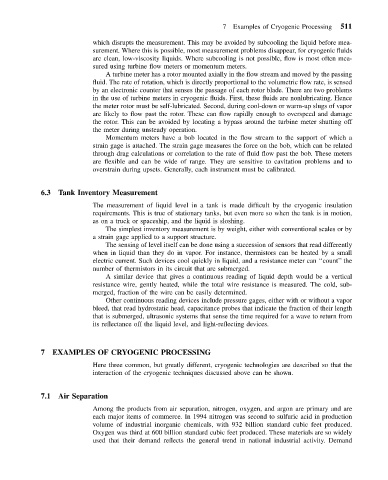Page 522 - Mechanical Engineers' Handbook (Volume 4)
P. 522
7 Examples of Cryogenic Processing 511
which disrupts the measurement. This may be avoided by subcooling the liquid before mea-
surement. Where this is possible, most measurement problems disappear, for cryogenic fluids
are clean, low-viscosity liquids. Where subcooling is not possible, flow is most often mea-
sured using turbine flow meters or momentum meters.
A turbine meter has a rotor mounted axially in the flow stream and moved by the passing
fluid. The rate of rotation, which is directly proportional to the volumetric flow rate, is sensed
by an electronic counter that senses the passage of each rotor blade. There are two problems
in the use of turbine meters in cryogenic fluids. First, these fluids are nonlubricating. Hence
the meter rotor must be self-lubricated. Second, during cool-down or warm-up slugs of vapor
are likely to flow past the rotor. These can flow rapidly enough to overspeed and damage
the rotor. This can be avoided by locating a bypass around the turbine meter shutting off
the meter during unsteady operation.
Momentum meters have a bob located in the flow stream to the support of which a
strain gage is attached. The strain gage measures the force on the bob, which can be related
through drag calculations or correlation to the rate of fluid flow past the bob. These meters
are flexible and can be wide of range. They are sensitive to cavitation problems and to
overstrain during upsets. Generally, each instrument must be calibrated.
6.3 Tank Inventory Measurement
The measurement of liquid level in a tank is made difficult by the cryogenic insulation
requirements. This is true of stationary tanks, but even more so when the tank is in motion,
as on a truck or spaceship, and the liquid is sloshing.
The simplest inventory measurement is by weight, either with conventional scales or by
a strain gage applied to a support structure.
The sensing of level itself can be done using a succession of sensors that read differently
when in liquid than they do in vapor. For instance, thermistors can be heated by a small
electric current. Such devices cool quickly in liquid, and a resistance meter can ‘‘count’’ the
number of thermistors in its circuit that are submerged.
A similar device that gives a continuous reading of liquid depth would be a vertical
resistance wire, gently heated, while the total wire resistance is measured. The cold, sub-
merged, fraction of the wire can be easily determined.
Other continuous reading devices include pressure gages, either with or without a vapor
bleed, that read hydrostatic head, capacitance probes that indicate the fraction of their length
that is submerged, ultrasonic systems that sense the time required for a wave to return from
its reflectance off the liquid level, and light-reflecting devices.
7 EXAMPLES OF CRYOGENIC PROCESSING
Here three common, but greatly different, cryogenic technologies are described so that the
interaction of the cryogenic techniques discussed above can be shown.
7.1 Air Separation
Among the products from air separation, nitrogen, oxygen, and argon are primary and are
each major items of commerce. In 1994 nitrogen was second to sulfuric acid in production
volume of industrial inorganic chemicals, with 932 billion standard cubic feet produced.
Oxygen was third at 600 billion standard cubic feet produced. These materials are so widely
used that their demand reflects the general trend in national industrial activity. Demand

